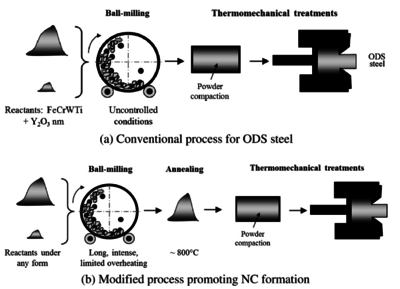Oxide dispersion-strengthened alloy
Oxide dispersion strengthened alloys (ODS) are used for high temperature turbine blades and heat exchanger tubing.[1] Alloys of nickel are the most common but work is being done on iron aluminum alloys.[2] ODS steels are used in nuclear applications.[3]
ODS materials are used on space crafts as a layer designed to protect the vehicle, especially during re-entry into the atmosphere. Also, noble metal alloy ODS materials, for example, platinum-based alloys, are used in glass production.
When it comes to re-entry at hypersonic speeds, the properties of gases change dramatically. Shock waves that can cause serious damage on any structure are created. Also at these speeds and temperatures, oxygen becomes very aggressive.
Mechanism
Oxide dispersion strengthening is based on incoherency of the oxide particles within the lattice of the material. The oxide particles decrease movement of dislocations within the material and in turn prevent creep. Since the oxide particles are incoherent, dislocations can only overcome the particles by climb. Whereas, if the particles were semi-coherent or coherent with the lattice, the dislocations can simply shear the particles. Climb is less energetically favourable (occurs at high temperatures) than simply shearing and therefore stops dislocation movement more effectively. Climb can occur either at the particle-dislocation interface (local climb) or by overcoming multiple particles at once (general climb). General climb requires less energy and therefore is the common climb mechanism. The presence of incoherent particles introduces a threshold stress (σt), since an additional stress will have to be applied for the dislocations to move past the oxides by climb. Moreover, dislocation even after overcoming particle by climb can still remain pinned at the particle-matrix interface with an attractive phenomenon called interfacial pinning[4][5] which further requires additional threshold stress to detach a dislocation out of this pinning, which must be overcome for the plastic deformation to occur.[6] The following equations represent the strain rate and stress as a result of the introduction of oxides in the material.
Strain Rate:
Threshold Shear Stress:
Synthesis
The creep properties of ODS steels are highly dependent on the characteristics of the nano-oxides particles which exist in the metal matrix, specifically the ability of these particles to prevent dislocation motion as well as the size and distribution of the particles. Hoelzer and coworkers have shown that an alloy containing a homogeneous dispersion of 1-5 nm Y2Ti2O7 nanoclusters has superior creep properties to an alloy with a heterogeneous dispersion of 5-20 nm nanoclusters of the same composition.[7] In the pursuit of new ODS steels it is important to focus on processes that allow for the formation of a dense homogeneous dispersion of small nanoclusters.

ODS steels are commonly produced through ball-milling an oxide of interest (e.g. Y2O3, Al2O3) with pre-alloyed metal powders followed by compression and sintering of the material. It is believed that the nano-oxides enter into solid solution with the metal during ball-milling and subsequently precipitate during the thermal treatment to yield the ODS steel. This process seems simple but many parameters need to be carefully controlled to produce a well made alloy. Work by Leseigneur and coworkers has been done to carefully control some of these parameters in order to get more consistent and better microstructures in ODS steels.[8] In this two step method the oxide is ball-milled for longer periods of time to ensure a homogeneous solid solution of the oxide in the metal matrix. Then the powder is annealed at higher temperatures to begin a controlled nucleation of the nano-oxide clusters. Finally the powder is again compressed and sintered to yield the final material.
Advantages and disadvantages
Advantages:
- Can be machined, brazed, formed, cut with available processes.
- Develops a protective oxide layer that is self-healing.
- This oxide layer is stable and has a high emission coefficient.
- Allows the design of thin-walled structures (sandwich).
- Resistant to harsh weather conditions in the troposphere.
- Low maintenance cost.
- Low material cost.
Disadvantages:
- It has a higher expansion coefficient than other materials, causing higher thermal stresses.
- Higher density.
- Lower maximum allowable temperature.
See also
References
- ↑ TLP Diffusion Bonding of a ODS Nickel Alloy
- ↑ Optimization of High Temperature Hoop Creep Response in ODS-Fe3Al Tubes
- ↑ Klueh, R. L.; Shingledecker, J. P.; Swindeman, R. W.; Hoelzer, D. T. (2005). "Oxide dispersion-strengthened steels: A comparison of some commercial and experimental alloys". Journal of Nuclear Materials. 341 (2–3): 103. doi:10.1016/j.jnucmat.2005.01.017.
- ↑ "Threshold stresses for dislocation climb over hard particles: The effect of an attractive interaction". doi:10.1016/0001-6160(86)90247-6.
- ↑ Reppich, B. (1998-12-19). "On the attractive particle–dislocation interaction in dispersion-strengthened material". Acta Materialia. 46 (1): 61–67. doi:10.1016/S1359-6454(97)00234-6.
- ↑ Chauhan, Ankur; Litvinov, Dimitri; de Carlan, Yann; Aktaa, Jarir (2016-03-21). "Study of the deformation and damage mechanisms of a 9Cr-ODS steel: Microstructure evolution and fracture characteristics". Materials Science and Engineering: A. 658: 123–134. doi:10.1016/j.msea.2016.01.109.
- ↑ Hoelzer DT, Bentley J, Sokolov MA, Miller MK, Odette GR, Alinger MJ. J Nucl Mater 2007;367:166.
- ↑ Laurent-Brocq, M., et al. "Influence of ball-milling and annealing conditions on nanocluster characteristics in oxide dispersion strengthened steels." Acta Materialia 60.20 (2012): 7150-7159.